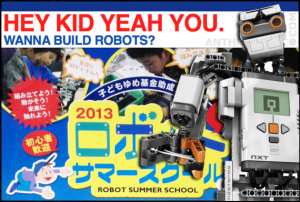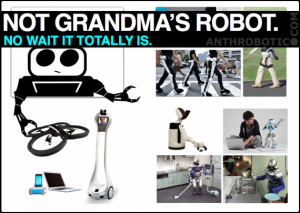Section A is furious anger at robotics coverage and the corpsifying institution of journalism in general. Section B is some very interesting robotics news from Japan (telepresence robotic heavy equipment operation!). Section C is the bow on the whole thing, so choose your own adventure(s)!
• • •
[ORIGINALY PUBLISHED LAST NIGHT AT AKIHABARANEWS.COM BUT REPUBLISHED HERE BECAUSE I DO WHAT I WANT, SON.]
Editor’s Actually Necessary Choose Your Own Adventure Trigger Warning:
For readers who just want the robo-news: skip down to Section B. For readers who’d like to see the author aggressively burn about 800 colorful words attacking the state of robotics coverage and journalism in general: begin with Section A. Section C is best with both A and B, JYSK.
A.
It Totally Makes Sense to Believe that Robots are Going to Steal Tons of Human Jobs Like, Really Soon
So, all those dire headlines (↓) we’ve seen over the past year and beyond, tossing out the warnings and what-ifs about job-thieving robots, they’re for real, right? They can’t all be link-baiting, fear-mongering, mob-mentality-fluffing, armchair-quarterbacked-from-the-technological-cheap-seats, irresponsible speculation can they? We humans have to fear our new robot overlords, right?
Well, first of all, yes – it is indeed accurate that an increasing number of industrial and service robots are going to work. Beyond speculating based on that fact alone, however, beyond drama queen talking head “technology experts” and the gee-whiz hand wringing of jargon-lobbing economists, there is effectively zero data to support concerns over said robots absconding with a net number of human jobs. Yet still:

Now, on the other side of the issue, data overfloweth: (take a deep breath) the International Federation of Robotics recently published a 70-page document based on the conclusions of a robotics-dispassionate industrial research firm that surveyed companies with more than 250 employees working in the automotive, electronics, food and beverage, chemical & pharmaceutical, and plastics industries across six countries including Brazil, China, Germany, Japan, the Republic of Korea, and the USA, and (pause for inhale)…it’s called the Positive Impact of Industrial Robots on Employment report. It’s huge, and it’s far from being the only such evidence (more on that: The Economic Impact of the Robot Revolution).
Nutshelled:
Team Fear of Robot-Driven Employment Apocalypse:
Uhhhh…Yeah, speculation. Anecdote. No data.
Team Robotics Has a Really Positive Impact on Employment:
Meticulously documented. Widely accepted by experts.
Oddly, both platforms are taken seriously in public discourse. Weird, right?
…all of the sudden, the composition Hulkifies:
Alright, so here’s the thing:
Yes, we humans are supertech and we make awesome robots and we’ve seriously evolved our technological civilization. BUT, as newspeople well know, fear of the Other and Divisive Tribal Dynamics are still hardwired into our squishy brains. As such, when the Other gets painted as an impending wave of emotionless, mechanized labor-class facsimiles, it shifts a species-level bandwagoning into overdrive.
Far from accidental, this is a carefully calculated provocation. Let’s for a moment reconsider that handful of 2014’s most popular robo-jobby headlines: the sensational hyperbole, glaring leaps of logic, and the aforementioned data-lacking speculation run throughout, but the terrible reporting actually begins right out front:
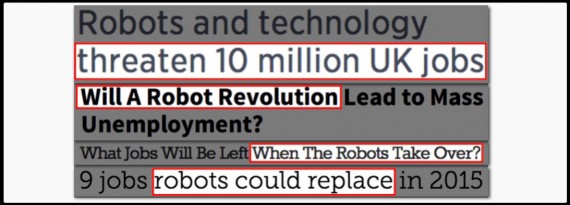
Given that the U.K. only has about 30 million total workers, that’s probably the dumbest in a range of dumb excreted by what are supposed to be globally respected news sources, the biggest names in publishing – and yes, they are real headlines. You can go find them if you like, but we’re not going to dignify pandering pseudojournalism with hyperlinks.
…which is a quaint little protest on our part, but it means next to nothing – because readers will link, as will a swarm of parasitic minimedia scrapers; inflammation and polarization metastasize into an psychologically weaponized Us vs. Them dichotomy, which in turn adrenalizes our basest instincts and then…click…click…share…FORGET…lather…rinse…repeat.
It’s Bigger than Link Baiting;
You are Not Reading the News,
You’re Being Molested by It.
Half-assed, hacky reporting would be forgivable if it were simple ineptitude, but it ain’t that – it’s diabolical. As print media continues its pathetic swan song, online’s gotta get the clicks, the pageviews, the analytic show ponies for increasingly difficult to impress advertisers.
That’s the business now, and good writers crafting pieces of truth into enjoyable, informed, nuanced coverage…yeah, sorry – on that the masses do not click. So we’re all desperate, and we’re all making embarrassing professional sacrifices: we abandon investigative long-form, churn out filler for liquidity of content even if it’s crap; and then, when we have time, either start a fight or arouse a teenage boy. Boom Goes the Journalism.
“TL:DR,” the Intellectual Firewall of the Masses, the Rallying Cry of the Self-Retarding; a New Media Algorithm
Our case in point is robotics and employment, but the entire Institution of Media & Journalism is beset with this rot. Disingenuous headlines lure us to formulaic sawdust featuring either celebrity buttcheeks or inflammatory jabs aimed at the reactionary-est common denominator – it’s survival of the fittest, and fit in today’s media landscape sadly means either super-dumb, super-safe, super-misleading, or a combo thereof.
You Read Quickly Made Terribly Enticing Sharable Trendable Divisive Disposable Brain Candy Impregnated with a Failsafe of Plausible Deniability; It’s Technically Not Lying in the same way the Charles Manson didn’t Technically Kill Anyone.
It’s sad. It sucks. It’s your fault and mine.
Anyway, if you want real robotics news, yours truly drops a few words from from time to time, but it’s nothing to depend on because I’m pretty busy running a mid-size tech website into the ground – so don’t count on a whole lotta that. The non-profit Robohub.org, operated by some of planet Earth’s foremost robotics researchers and practitioners, is by far your best bet. Anthrobotic.com and AkihabaraNews do have a relationships with Robohub, but it’s not a conflict of interest, it’s how we know that their robotics coverage and content is fantastic, while almost everything else is straight-up garbage.
B.
(FINALLY WHAT WE REALLY WANTED TO TALK ABOUT) Japanese Robots: Kowa Tech’s ActiveRobo SAM Surrogate Operator
In the final stretch of last October’s Nikkan Kogyo Journal-sponsored Japan Robot Week, as we were just about to pack up the harvest of glossy pamphlets and business cards and join the stream of tired feet returning inland from the Tokyo Big Sight convention center, a bright blue, herky-jerky robot in a chair caught our attention. With maybe 20 minutes of the 3-day event remaining, still humming along on the relative sidelines was Kowa Tech’s ActiveRobo SAM.
Offering little more than a kind of headless, doubled-over skeleton strapped to an office chair, a rep shuffling around with a big remote control, and a TV looping their demo video, the Kowa Tech booth wasn’t seeking nor receiving a whole lot of attention, and had the floor not been almost empty of attendees we probably would have missed it (yeah, that’s on us). Also, to be fair, they are new to the robo-tradeshow, and, as you’ll see in the video below, an indoor venue really isn’t the place to go all real-world with Kowa Tech’s new product.
Kowa Tech
Counting nearly all of Japan’s major automotive companies as clients, the Tokyo-based engineering firm specializes in custom-built mobile entertainment rigs, emergency response and law enforcement vehicles, medical examination and treatment vehicles, and even some fun stuff like an amphibious tour bus.

Lighting; Hazardous Fluid Response; Amphibi-Bus, Mobile Mammogram (Kowa Tech)
While not a robotics company per se, several of the their task- and industry-specific products incorporate hydraulic and pneumatic extenders and manipulators, which, as a platform of expertise, makes a foray into stand-alone robotic systems less a reach and more of a choice.
Simple Utility: Kowa Tech’s ActiveRobo SAM
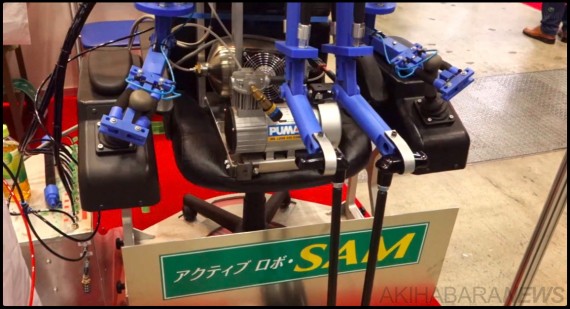
Pictured above and below (with a brief clip from the Japan Robot Week demo), this collection of appendages in vaguely humanoid form is the business end of a remotely directed robotic vehicle control system. Conceptually, it’s quite simple: joysticks, knobs, and switches manipulated on a custom radio controller direct the flexing and relaxing of pneumatic “artificial muscles” arranged along “arms and legs” that attach to a vehicle’s pedals and levers to replicate a human body’s controlling movements.
Kowa Tech claims the system delivers controlling strength equal to that of human limbs and an overall operational capability 80% that of in-vehicle operation (with gains expected as the system matures). The 3-piece modular robot is weather and vibration-proof, weighs only about 30 kg (66 lbs.), easily installs in under 30 minutes, and can be removed in half that time. Current prototypes are operable from up to 200m, and commercial models are expected to reach 1 kilometer.
Rounded out with video monitoring for an in-vehicle perspective, in theory ActiveRobo SAM is a near-comprehensive surrogate operator. Most of their demos and testing have thus far been limited to excavator and other heavy equipment work, but the company hopes to eventually make the system adaptable to any vehicle.

IMAGES: Kanagawa Prefecture’s Robot Town Sagami
Removable Robot Enables an Entire Fleet
Roboticising and/or remotely controlling heavy equipment and other vehicles is novel neither in concept nor implementation. Full-scale R/C vehicles have long been used in disaster zones where secondary dangers such as collapse, landslide, or toxic exposure remain, and they can minimize risks posed by landmines or improvised explosive devices in conflict zones.
While thoroughly useful and justifiable, extant systems require complicated internal wiring, additional actuation, and some measure of mechatronic retooling, all of which – and this is a fundamental shortcoming – is a very expensive, one-off investment in a single vehicle or piece of machinery. If a job depends on remote operation capability, routine breakdowns and damage or even a simple flat tire could at best delay time-sensitive work and at worst make a desperate situation worse.
If the ActiveRobo SAM can in practice deliver lightweight, modular portability with easy, rapid installation and removal across a range of vehicles and equipment, it’s no exaggeration to say that it could render a wide swath of currently available solutions obsolete. Whether for individual owners, government agencies, or large-scale rental operations (the latter being quite common in Japan), the potential domestic and international market for a simple, relatively affordable, adaptable and independently replaceable remote operation system is significant and largely untapped.
Development Partners & Incubation Initiatives:
The ActiveRobo SAM system was developed with support from Japan’s Ministry of Land, Infrastructure, Transport & Tourism (MLIT) as part of the Robotic Technology and Systems for Next-Generation Social Infrastructure initiative (次世代社会インフラ用ロボット技術・ロボットシステム) . It is also part of the Robot Town Sagami (さがみロボット産業特区) public relations and robotics education campaign orchestrated by the Kanagawa prefectural government. Additionally, Kowa Tech already has a corporate partner in Caterpillar Japan.
Competition:
Kowa Tech’s nearest rival here in Japan comes from contracting firm Fujiken’s DOKA ROBO, a similar though much more complex and traditionally humanoid telepresence robot that runs on SoftBank subsidiary Asratec’s V-SIDO robot OS. The ambitious, stand-alone humanoid is 150 cm tall, actually “sits” in the operator’s chair, and is expected to offer 3D remote viewing and a more familiar control scheme. The DOKA ROBO project is also part of MLIT’s Next-Gen Robotics Initiative and, as part of the exploration and development track, began its own round of trials and testing just last month.

IMAGES: MLIT Robotics Initiative and Fujiken (次世代社会インフラ用ロボット技術・ロボットシステム)
Purchase:
Kowa Tech is aiming for an April 2015 commercial release, making them considerably further along than any known competitor. If the company can deliver on its promises of simple installation and removal, if the system is easy to learn and use for both veteran and new operators, and if all this in concert can in fact produce a near-human surrogate, the ActiveRobo SAM system will not only be a coveted stand-alone product, but also an enticing option for Kowa Tech’s entire line of custom vehicles.
ActiveRobo SAM with Controller MSRP: $40,000-$50,000
C.
Addendum on Heavy Equipment Operators’ Post-Grad Practicum
It’s easy to appreciate how Kowa Tech’s ActiveRobo SAM and similar products prompt the subject of robotics and employment (in addition to bringing the issue outside of industrial factories where robotic systems have been replacing humans for decades). At first gloss, an operator simply shifting from in-vehicle to proximal operation seems a 1:1 trade-off. However, it’s actually quite illustrative of how, on one one hand, technological advances might subtly change or even eliminate certain roles, but on the other, simultaneously result in a net increase in available jobs.
Indeed, the number of operator jobs might remain static relative to market demand, but the robotic addition has a economic infrastructure all its own. Should the remote operation of heavy equipment and other vehicles increase beyond current levels, in addition to more timely and effective disaster response and risk reduction for operators, it would require the creation of new and/or expanded roles for instructors, programmers, maintenance workers, engineers, distributors, and equipment manufacturers (operator jobs could also become available to those with mobility impairment).
Robotics and/or other technological advancements will continue obviating human employment in so-called Dirty, Dangerous, and Demeaning work roles. No doubt, this steady reshaping of work necessitates new training, new skills, and new ways to do old jobs, but we should remember that since…oh, sometime around the first few years of the Industrial Revolution, this gradual evolution has proven to be a force for both job growth and human development.
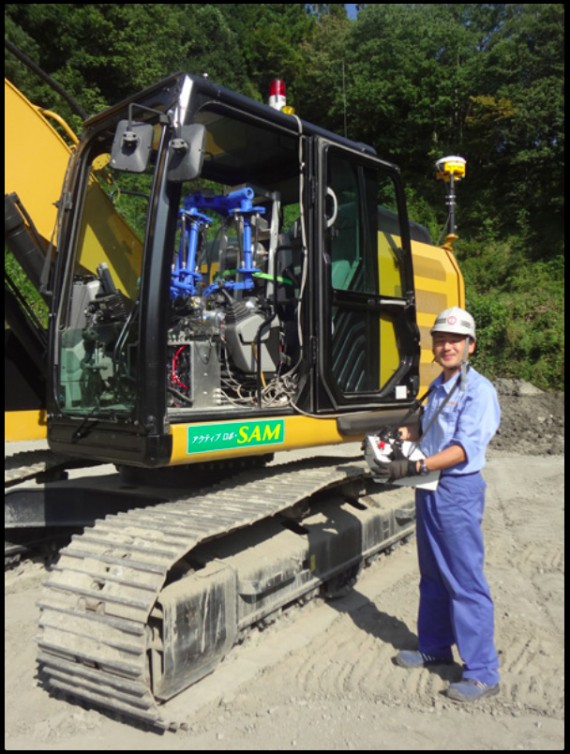
IMAGE: Kowa Tech
[ORIGINALY PUBLISHED AT AKIHABARANEWS.COM]



